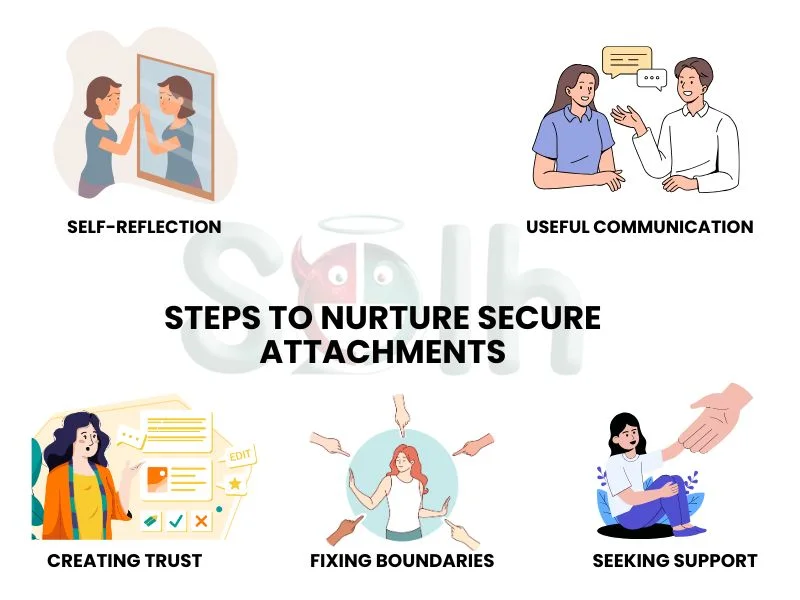British psychologist John Bowlby initially proposed attachment theory in the 1950s. This theory emphasizes the profound impact of early relationships on an individual’s emotional and relational well-being and the essence of understanding attachment styles and their function in our behaviors and relationships. If I talk about ‘secure attachments,’ it is crucial in cultivating healthy and fulfilling relationships, as they form the foundation for trust, intimacy, and emotional strength.
So here, we will explore the importance of secure attachments and the different attachment styles identified in the research. We will also learn practical strategies for nurturing and maintaining secure attachments in our personal and professional lives.
Wanna Understand Attachment Styles?
Interactions with the primary guardians within the child's productive years indicate how the child's attachment styles will develop. These attachment styles include secure, anxious, avoidant, and disorganized attachments.
Secure attachment is described by great trust, emotional expressiveness, and effective communication that fosters a healthy bond between the child and the guardian.
Conversely, anxious and avoidant attachments emerge from inconsistent care and unmet emotional needs. Such attachments create the child's relational patterns and emotional responses.
Why Secure Attachments is Essential?
Colossal research has consistently indicated that secure attachments significantly improve an individual’s mental health, interpersonal relationships, and overall well-being or health. Those with secure attachments are likelier to show strength in the face of trouble and indicate higher levels of empathy and the capacity to form and maintain long-lasting, healthy connections with others.
Additionally, personal histories and real-life experiences help to highlight the profound and transformative impact that secure attachments can have on an individual’s life.
Identify Your Attachment Style
Comprehending attachment style can offer valuable insights into your relationships, emotional patterns, and behaviors. Here is a self-assessment guide to assist you in identifying your attachment style and explaining how these styles show in relationships.
We will also understand typical behaviors related to each attachment style, providing readers with a deeper understanding of how attachment styles are present in their own lives. By nurturing readers to feel about their past experiences and current relationships, we encourage self-discovery and a greater understanding of attachment styles and their impact.
So, let’s start!
Step 1: Self-Reflection Questions
Ask yourself the following questions to get a sense of how you relate to others emotionally:
1. How do you feel when your partner or a loved one is emotionally distant?
Do you feel anxious or worried about the relationship?
Are you comfortable giving them space?
2. When disagreements or conflicts arise, how do you typically react?
Do you avoid the confrontation or withdraw?
Do you feel the need to resolve it immediately, fearing loss?
Are you calm and open to dialogue?
3. How do you behave in the early stages of a relationship?
Are you eager for closeness and reassurance?
Do you hesitate to become too attached?
Are you able to balance closeness with independence?
4. How do you feel about depending on others or being depended on?
Do you feel overwhelmed when others depend on you emotionally?
Do you expect others to meet your emotional needs completely?
Step 2: Identifying Your Attachment Style
Based on your answers, here are four common attachment styles and how they may manifest in relationships:
Secure Attachment–
Key Behaviors
You feel comfortable with intimacy and independence. You can openly express emotions, trust your partner, and feel secure even apart.
In Relationships:
You tend to have stable, balanced relationships. You handle conflicts with communication and trust your partner’s commitment.
Anxious (Preoccupied) Attachment–
Key Behaviors
You crave closeness but often fear rejection or abandonment. You may become overly dependent on your partner for emotional validation.
In Relationships
You may experience insecurity and need constant reassurance from your partner. If they're not emotionally present, you might overanalyze their actions or feel anxious.
Avoidant (Dismissive) Attachment–
Key Behaviors
You value independence and may feel uncomfortable with too much emotional intimacy. You might avoid deep emotional connections.
In Relationships
You may appear distant, preferring to keep relationships at arm's length. You may struggle to express emotions or open up, leading to emotional disconnection.
Fearful-Avoidant (Disorganized) Attachment–
Key Behaviors:
You desire closeness but fear it, leading to conflicting emotions. Due to past traumas, you may struggle with trusting others.
In Relationships:
You may experience intense emotional highs and lows, pushing your partner away yet fearing abandonment. As a result, you might find it difficult to form stable, trusting relationships.
Step 3: Reflect on Your Past Experiences
Consider Past Relationships:
Reflect on how these behaviors have played out in your past relationships. Were you often anxious, distant, or comfortable with your partner?
Examine Current Relationships:
How do these attachment patterns affect your current relationships, whether romantic, familial, or friendships?
Step 4: Moving Forward
Understanding attachment style is the foremost step in encouraging healthier relationships. If you identify unhealthy patterns, think about it and explore ways to develop secure attachment through open communication, emotional awareness, and perhaps therapy.
By accumulating awareness of your attachment style, you can better navigate your emotional needs and build stronger, more fulfilling connections.
Steps to Nurture Secure Attachments

Here are five steps that will help you to nurture secure attachments:
Self-Reflection:
Regularly self-reflect to achieve insights into your emotional patterns, triggers, and responses. Consider how past experiences may affect your current interactions and relationships.
Useful Communication:
Improve your communication skills by practicing active listening, empathetic understanding, and transparent and honest expression. Pay attention to non-verbal signals and work on encouraging genuine and respectful dialogue.
Creating Trust:
Build trust by being transparent, dependable, and consistent in your words and actions. Follow through on your commitments and be mindful of the impact of your behavior on the other person.
Fixing Boundaries:
Set and maintain healthy boundaries to make you and the other person feel safe and respected. Express your boundaries clearly and be mindful of respecting the boundaries of others.
Seeking Support:
Don’t hesitate to take advice and support from trustworthy friends, family members, or professionals. Discuss your experiences and challenges, and be genuine and transparent about acquiring insights and advice to help nurture and maintain secure attachments.
Navigating Challenges in Attachment
Common problems to be worked on to the maximum extent in creating secure attachments are past trauma or fear of intimacy. When one has past trauma or struggles with fear of intimacy, it tends to make it challenging in terms of forming secure attachments with others. Therefore, this is an area where natural healing and growth strategies can be launched.
A good strategy could involve gradual exposure to intimacy and becoming comfortable with closeness and vulnerability over time. This may mean starting small, such as sharing personal thoughts and feelings with a trusted person while developing trust, and then gradually becoming more emotionally intimate.
Vulnerability practice is another critical point for developing a secure attachment. It means being open and honest about your emotions and needs despite the discomfort or even fear that it may cause. In safe and supportive environments, vulnerability practice can help you learn to build trust and deepen connections with others.
It can only be overcome with patience and self-compassion. One needs to be gentle with oneself as one approaches these hurdles, and when the issues seem too much, one needs to look forward to support from trusted others or professionals. With dedication and a readiness to grow, people can develop secure attachments and go on to form meaningful relationships.
Conclusion
We understand the essential aspects of developing secure attachments. We have highlighted that this journey of nurturing secure attachments profoundly benefits individuals and their relationships. Finally, we strongly encourage our readers to take proactive and purposeful steps towards helping secure attachments in their lives, as this will lead to greater well-being and fulfillment.
Solh understands. We offer a variety of features to help you invest in self-care.
Journaling for Self-Reflection: Sometimes, being unable to care for yourself can come from a lack of self-understanding. Solh's journaling feature allows you to explore your thoughts and feelings in a safe space. By reflecting on your experiences and desires, you can clarify what stops you from self-care.
Anonymous Support Groups: You are not alone. Solh's anonymous support groups connect you with others who understand the struggle. Share your experiences, find comfort in solidarity, and discover new perspectives on overcoming the hurdle to indulge in self-care.
Solh Buddy: Feeling lost or disconnected? Your Solh Buddy, a personalized virtual companion, is here to provide encouragement and support. It can offer prompts, celebrate your victories, and remind you of your strengths as you navigate the journey toward self-care.
Talk now: Sometimes, self-care can make you feel overwhelmed. Solh's Talk Now feature gives you access to dedicated counselors who can help you navigate such situations.
Solh believes in a unique approach to introducing self-care. We empower you to take charge of your well-being by offering a variety of tools. Explore Solh today and discover the power of self-reflection, connection, and support in overcoming any problem of the mind. You are not alone on this path.








